Entering the Polling Place
D. Building Entrance
Typical Issues
An accessible polling place must have at least one accessible entrance. The accessible entrance must be connected to an accessible route. An accessible entrance must provide at least one accessible door with maneuvering space, accessible door hardware, and enough clear width to allow people who use crutches, a cane, walker, scooter or wheelchair to use it.
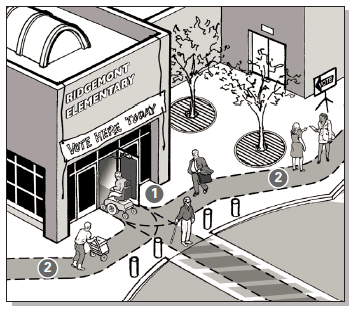
Notes:
1. Accessible entrance to the polling place.
2. Accessible route connecting accessible parking and drop-off area (if provided) to the accessible entrance.
If the accessible entrance is not the main entrance to the polling place, then signs must be located at inaccessible entrances to the polling place to direct voters to the accessible entrance. The accessible entrance must remain open when the polling place is open.
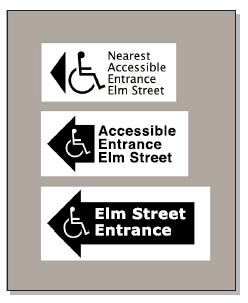
Examples of signs for inaccessible polling place entrances directing a voter to the accessible entrance.
Building Entrance Checklist
D1. Is there at least one accessible entrance connected to an accessible route?
[ADA Stds 4.1.3(1)]
Notes: If this entrance is not the main entrance, it needs to be kept unlocked during voting hours. If there are inaccessible entrances serving the polling place, signs will be needed at inaccessible entrance(s) to direct voters to the nearest accessible entrance.
Yes _____ No _____
D2. Does at least one door or one side of a double leaf door at the accessible entrance provide at least 32 inches clear passage width when the door is open 90 degrees?
[See figure 24 in the appendix at the back of the checklist]
Yes _____ No _____
If No, does another entrance have an accessible door or can both doors be propped open during voting? Other possible solutions are to enlarge the door opening, use a swing clear hinge, or, if a double leaf door, use uneven width doors.
D3. Is the door hardware (e.g., lever, pull, panic bar) usable with one hand without tight grasping, pinching, or twisting of the wrist? [ADA Stds 4.13.9]
Yes _____ No _____
If No, leave door propped open, add new accessible hardware, or adapt/replace hardware.
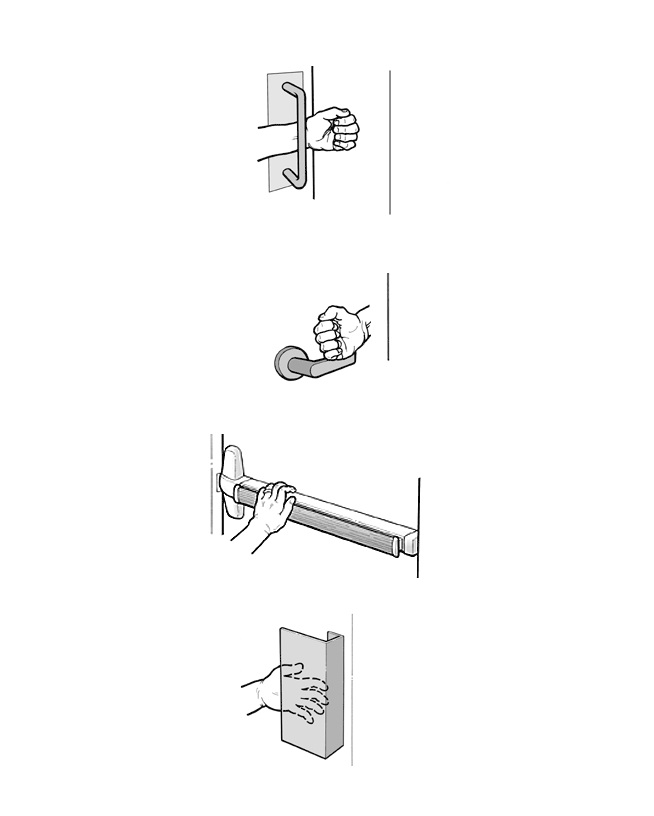
Examples of handles and door hardware that can be used without tight grasping, pinching, or twisting.
D4. On the pull side of the door, is there at least 18 inches clearance provided to the side of the latch if the door is not automatic or power-operated? [ADA Stds 4.13.6, figure 25]
Note: The maximum threshold height is 1/2 inch for new construction.
If No, leave the door propped open, install a power operator, or look for another accessible entrance.
Yes _____ No _____
D5. If there is a raised threshold, is it no higher than 3/4 inch at the door and beveled on both sides? [ADA Stds 4.1.6(3)(d)(ii), 4.13.8]
Yes _____ No _____
If No, replace threshold with one with beveled sides or add sloped insert to threshold.
D6. If an entry has a vestibule, is there a 30-inch by 48-inch clear floor space inside the vestibule where a wheelchair or scooter user can be outside the swing of a hinged door?
[ADA Stds 4.13.7]
Yes _____ No _____
If No, leave the inner door open or remove inner door, add power operators to both doors so they open at the same time or, modify the vestibule.
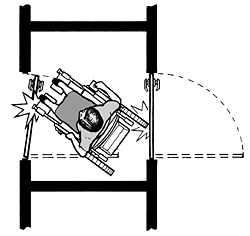
Insufficient space between doors makes the alcove inaccessible.
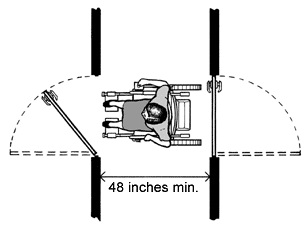
Minimum alcove depth of 48 inches if both doors open out
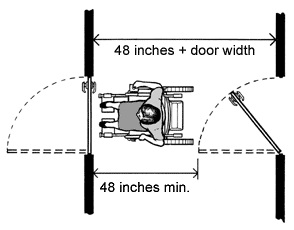
Minimum alcove depth of 48 inches + door width when door swings into alcove
Temporary Solutions for Election Day
Accessible Entrance to Polling Place
Problem One:
One or two steps at the entrance prevent access.
Suggestion: If another entrance is accessible and on an accessible route from accessible parking, designate it as the accessible entrance and install a directional sign at the main entrance directing voters to the accessible entrance. Keep the accessible entrance unlocked during voting hours.
If another accessible entrance is not available, install a temporary ramp with edge protection and handrails.
Problem Two:
There is a small step at the entrance.
Suggestion: Install a short temporary ramp to provide a smooth transition.
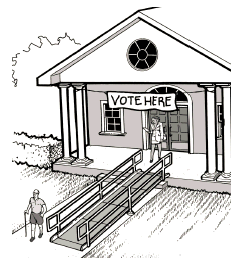
Problem Three:
Entrance door threshold has an abrupt change in level of more than 1/4 inch and no beveled sides.
Suggestion: If the threshold is not more than 3/4 inches high, add beveled surfaces to both sides of the threshold or replace with a new threshold that is no more than 1/2 inch high and that has beveled sides.
Problem Four:
Entrance door to the building is heavy and difficult to open.
Suggestion: Keep the door propped open or station volunteers near the door to open it for voters.
Problem Five:
Door handle and/or latch at the entry door is not accessible.
Suggestion: These are three typical solutions: add an accessible pull or handle to the outside of the door and leave the door unlatched, or install an accessible door handle and hardware, or leave the door propped in an open position.
E. Hallways and Corridors
Part 1. Typical Issues for Voters Who Use Wheelchairs, Scooters, or Other Mobility Devices
The interior accessible route connects the accessible entrance with the voting area. Typically made up of hallways, corridors, and interior rooms and spaces, the accessible route is essential for people who have difficulty walking or who use wheelchairs or other mobility aids to get to the voting area.
An accessible route is at least 36 inches wide and may narrow briefly to 32 inches wide where the route passes through doors or next to furniture and building elements. High thresholds, abrupt level changes, steps, or steeply sloped hallways cannot be part of an accessible route. Where ramps are used, they cannot be steeper than 1:12. Ramps with a vertical rise of more than 6 inches must have handrails on both sides. Ramps must also have edge protection to stop wheelchairs from falling off the sides, and level landings at the top and bottom of each segment and where a ramp changes direction.
Where an accessible route is different from the route used by most voters, signs will be needed at key decision points to direct voters with disabilities to the voting area.
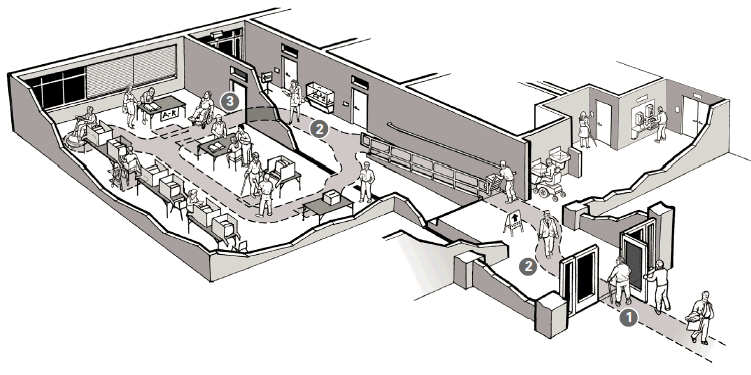
Interior of a polling place showing the accessible route from the accessible entrance to the voting area.
Notes:
1. Accessible entrance
2. Accessible route connects the accessible entrance with the voting area.
3. Accessible door to the voting area
E1-1. Is there an accessible route, at least 36 inches wide that connects the accessible entrance to the voting area (the accessible route may narrow to 32 inches wide for up to 2 feet in length)?
Yes _____ No _____
E1-2. Is the accessible route free of steps and abrupt level changes over 1/2 inch (level changes between 1/4 inch and 1/2 inch should be beveled)? [ADA Stds 4.1.3(1), 4.3.8]
Yes _____ No _____
E1-3. Does the route from the accessible entrance to the voting area change levels using a ramp, lift or elevator?
Yes _____ No _____
If no, go to question E1-7.
3a. If yes, is a ramp or sloped hallway provided?
Yes _____ No _____
If yes, go to question E1-4.
Note: A ramp, lift, or elevator can be used to provide access to floor levels.
3b. Is an elevator provided or lift provided?
Yes _____ No _____
If an elevator is provided, go to question E1-5. If a lift is provided, go to question E1-6.
E1-4. Where the slope of the accessible route is greater than 1:20, does this part of the accessible route meet the following requirements for an accessible ramp?
Yes _____ No _____
4a. Is the slope no greater than 1:12? [ADA Stds 4.8.2]
Yes _____ No _____
Note: For existing ramps, the slope may be 1:10 for a 6 inch rise and 1:8 for a 3 inch rise in special circumstances, see ADA Standards 4.1.6(3).
4b. Is the ramp width, measured between handrails, at least 36 inches?
[ADA Stds 4.8.3]
Yes _____ No _____
4c. Are the handrails mounted between 34 and 38 inches above the ramp surface?
[ADA Stds 4.8.5]
Yes _____ No _____
4d. If a ramp is more than 30 feet long, is a level landing at least 60 inches long provided every 30 feet of horizontal length? [ADA Stds 4.8.4]
Yes _____ No _____
Note: When the running slope is less than 1:16 and more than 1:20, each ramp segment may be up to 40 feet long followed by a level landing.
4e. Does the ramp have a level landing at the top and bottom of each ramp section that is at least 60 inches long? [ADA Stds 4.8.4]
Yes _____ No _____
Note: The level landing may be part of the sidewalk or walking surface.
4f. Is a level landing, at least 60 inches by 60 inches, provided where a ramp changes direction? [ADA Stds 4.8.4]
Yes _____ No _____
4g. If the ramp or landing has a vertical drop-off on either side of the ramp, is edge protection provided? [ADA Stds 4.8.7]
Yes _____ No _____
E1-5. Is an elevator provided to access the voting area level?
Yes _____ No _____
5a. Are the elevator call buttons mounted in an accessible location with the centerlines at 42 inches above the floor? [ADA Stds 4.10.3]
Yes _____ No _____
5b. Does the floor area of the elevator car provide space for wheelchair users to enter, reach the controls, and exit the car? [ADA Stds 4.10.9]
Note: See Figure 22 for acceptable floor and opening dimensions. Floor dimensions of at least 48 inches by 48 inches may be allowed in existing facilities built before the ADA went into effect.
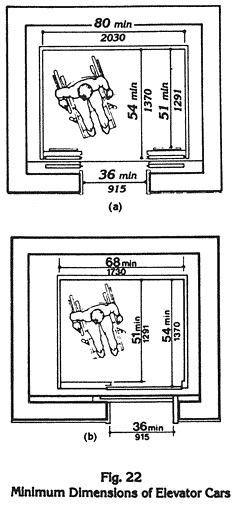
5c. Are the highest floor control buttons in the elevator cab mounted no more than 54 inches above the floor for a side reach or 48 inches for forward reach?
Yes _____ No _____
5d. Are raised letters and Braille characters used to identify each floor button and each control? [ADA Stds 4.10.12]
Yes _____ No _____
5e. Are signs mounted on both sides of the elevator hoistway door opening that designate the floor with 2-inch minimum-height raised letters and Braille characters centered at 60 inches above the floor? [ADA Stds 4.10.5]
Yes _____ No _____
5f. Is the elevator equipped with audible tones or bells or verbal annunciators that announce each floor as it is passed? [ADA Stds 4.10.13]
E1-6. If a wheelchair lift is provided, does it meet the following requirements:
6a. Is the lift operational at the time of the survey?
Yes _____ No _____
6b. Is the change in level from the floor to the lift surface ramped or beveled?
Yes _____ No _____
6c. Is there at least a 30-inch by 48-inch clear floor space on the wheelchair lift?
Yes _____ No _____
6d. Does the lift allow a wheelchair user unassisted entry, operation, and exit?
Yes _____ No _____
6e. Are the controls and operating mechanisms mounted no more than 54 inches above the floor for a side reach or 48 inches for a forward reach?
Yes _____ No _____
6f. Are the controls and operating mechanisms usable with one hand without tight grasping, pinching, or twisting?
E1-7. At each location on the way to the voting area where the accessible route passes
through a door or doors, does at least one door meet the following requirements?
Yes _____ No _____
7a. Is the clear width for the door opening at least 32 inches measured when the door is open 90 degrees? [ADA Stds 4.1.3(7), 4.13.5]
Yes _____ No _____
7b. Is the door hardware (e.g., lever, pull, push, panic bar) usable with one hand, without tight grasping, pinching, or twisting of the wrist, to allow people who may not be able to easily use one or both hands to fully operate the hardware?
[ADA Stds 4.13.9]
Yes _____ No _____
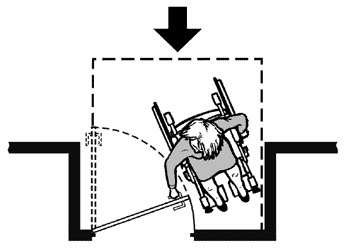
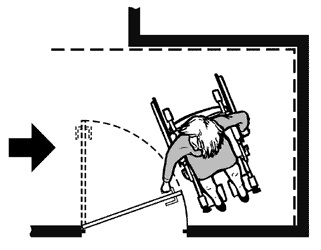
A clear floor space on the latch side of the door (pull side) allows a person using a wheelchair or scooter to pull the door open and then enter. The size of the clear floor space varies depending on the direction of approach (shown by the arrows) and the door swing.
7c. Is there clear maneuvering floor space in front of each accessible door (see Figure 25 in the appendix for measurements) and on the pull side, is there at least 18 inches clear floor space beyond the latch side of the door (see space configurations in Figure 25)? [ADA Stds 4.13.6]
7d. Is no more than 5 pounds force needed to push or pull open the accessible door?
Yes _____ No _____
Note: Fire doors are still considered to be accessible if they have the minimum opening force allowable by the appropriate administrative authority.
Yes _____ No _____
7e. If the answers to questions (b) thru (d) are no, can the door be propped open to provide an accessible route on election day?
Temporary Solutions for Election Day
Interior Hallways and Corridors to Voting Area
Problem 1:
One or more steps along hallway to voting area block access.
Suggestion: Install a portable ramp with edge protection and handrails as shown in the figure or relocate the accessible voting to another area that is on an accessible route.
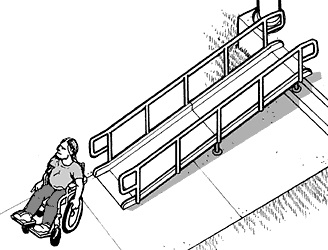
A portable ramp with edge protection and handrails is placed over stairs to provide an accessible route on Election Day.
Problem 2:
Voting area is not on an accessible route and cannot be made accessible.
Suggestion: Look for another area where accessible voting may be provided. For example, if the living room of a private home used for voting is up several steps, perhaps the garage may be accessible when entered from the driveway. Or, if a church’s basement is used as a polling place and it is not accessible, perhaps one of the ground floor rooms could be used as the accessible voting area.
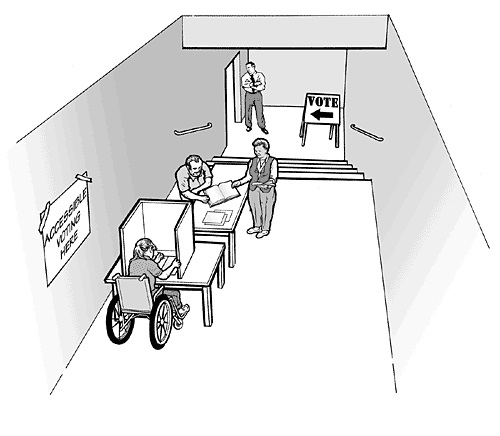
An accessible voting station is provided on an accessible level in a facility where voting occurs downstairs.
Part 2. Typical Issues for Voters Who are Blind or Who Have Low Vision
People who are blind or have low vision may walk along any route to access the voting area, not just the accessible routes. That means pedestrian routes open to voters serving or leading to the voting area, such as hallways, corridors and the voting space, must be free of objects that cannot be detected by a person who is blind or visually impaired. Objects that are wall-mounted, that project into a pedestrian route from the side, or that are overhead must be located so that voters who are blind or who have a visual impairment will either detect the objects before they run into them or safely pass under them. These routes must be free of overhanging objects that are less than 80 inches above the floor and side objects that protrude into the route more than 4 inches when the bottom of the object is more than 27 inches above the floor. Items to watch for include wall-mounted fire extinguishers and wall-mounted display cases when the bottom is more than 27 inches above the floor, wall sconces and light fixtures that protrude more than 4 inches off the wall, and open staircases, exit signs, overhead signs, banners, and arched doorways that are lower than 80 inches above the floor.
The following checklist applies to pedestrian routes serving or leading to the voting area.
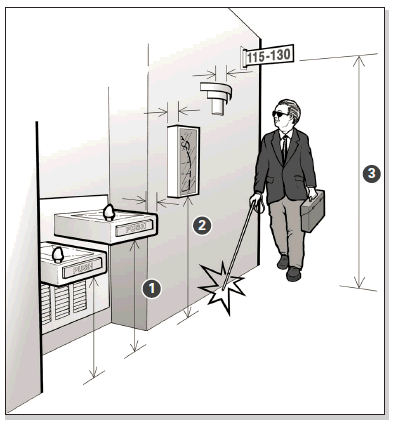
Overhead and wall-mounted objects that may be hazards along a pedestrian route.
Notes:
1. Wall-mounted drinking fountains are a hazard when the front projects more than 4 inches beyond the wall and the bottom is more than 27 inches above the floor.
2. Wall-mounted objects cannot project more than 4 inches beyond the wall if the bottom is not in the cane-detectable area below 27 inches off the floor.
3. Overhead objects must be at least 80 inches off the floor.
E2-1. Are pedestrian routes leading to or serving the voting area free of objects that protrude from the side more than 4 inches into the route with the bottom of the object more than 27 inches above the floor? [ADA Stds. 4.4]
Note: These objects may be wall mounted or free standing. Items to check include wall-mounted fire extinguishers, light fixtures, coat hooks, shelves, drinking fountains, and display cases. If No, list the objects that are a hazard and their location. Placing a detectable object on the floor below each object may remove the hazard for election day.
Yes _____ No _____
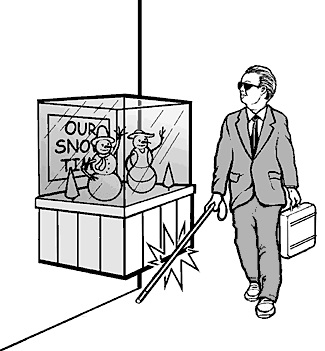
If the bottom of an object is not more than 27 above the floor, it may extend an unlimited amount from the wall.
E2-2. Are pedestrian routes leading to or serving the voting area free of overhead objects with the bottom edge lower than 80 inches above the floor?
Yes _____ No _____
If No, list the objects that are a hazard and their location. Placing a detectable object on the floor below each object may remove the hazard for election day.
E2-3. If provided, are the interior stairs along these routes built so that people who are blind or visually impaired cannot hit their heads on the underside (i.e., protected with a cane-detectable warning or a barrier that prevents travel into the area with less than an 80-inch-high head clearance)? [ADA Stds 4.4.2]
Yes _____ No _____
Temporary Solutions for Election Day
Hallways and Corridors - Voters Who are Blind or Who Have Low Vision
Problem One:
Wall-mounted display case is a protruding object hazard because it is more than 4 inches from the wall and the bottom of the case is more than 27 inches above the floor.
Suggestion: Place a detectable object or skirting below the case. The bottom of the skirting or detectable object must be no higher than 27 inches above the floor.
Problem Two:
Ceiling or wall-mounted television monitor has less than 80 inches of clearance between the floor and the bottom of the unit.
Suggestion: Place a detectable object below the unit (no more than 27 inches above the floor) so a voter who is blind will not walk into the television.
Problem Three:
The bottom of a stair is open and voters who are blind or who have low vision can hit their heads on the underside of the stair.
Suggestion: Provide a detectable fence or other object so voters cannot walk under the stair.
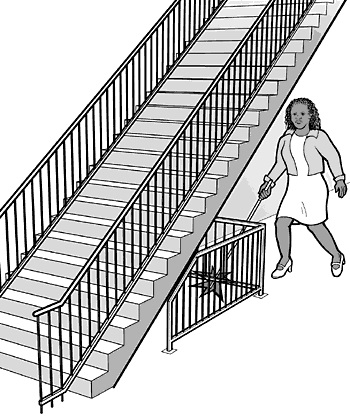
A detectable fence placed under this stair keeps people from running into the bottom of the open stair.

User Comments/Questions
Add Comment/Question